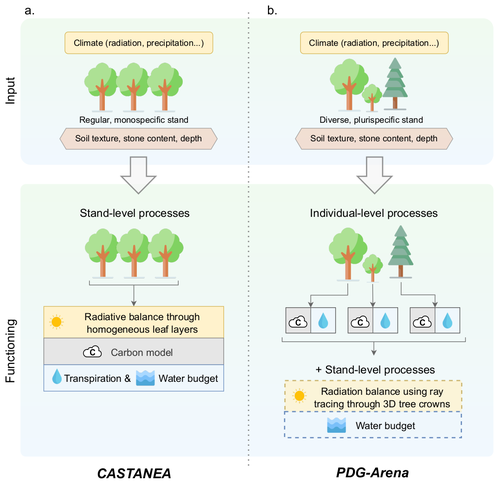
BUGMANN Harald
Recommendations: 0
Review: 1
Review: 1

PDG-Arena: An ecophysiological model for characterizing tree-tree interactions in heterogeneous and mixed stands
Is it possible to model and predict the growth of mixed-forests under a changing climate : some answers provided by the new model « PDG-Arena » developed on the CAPSIS platform.
Recommended by Erwin Dreyer based on reviews by Harald Bugmann and 1 anonymous reviewerThis interesting preprint develops a new model with a quite strange name (see below why this name was used by the authors) that aims at describing the growth of mixed forests (it may also be used for monospecific forests with a regular or irregular structure). It is based on two main features: it is a process-based model that integrates a tree-tree interaction module. The model derives from the modelling framework « Physio-demo-genetics model PDG » developed earlier at INRAE-Avignon, and « Castanea », developed at Orsay and Avignon as a widely used stand-level process-based model. « Arena » underlines the competition between trees in mixed stands. The « PDG-Arena » model was developed on the Capsis platform (https://capsis.cirad.fr/capsis/presentation), which is a shared platform for the development of tree growth models under a very open framework maintained by several French institutions.
The reviewers and the recommender saw two important strengths in the preprint : (i) PDG-Arena is definitely a significant improvement when compared to the existing models and may be used for accurately predicting the growth and dynamics of mixed stands ; (ii) it was validated against an impressive data set gained in a quite impressive network of mixed stands of beech (Fagus sylvatica L.) and silver fir (Abies alba Mill.) with a 5-year growth analysis at individual tree level (based on two detailed surveys at individual tree level. PDG-Arena could properly predict the growth of these stands and showed significant improvements for the existing models.
During the review process, many important questions were raised, some directly related to the manuscript (which the authors addressed very convincingly during the revision of the first version of the preprint), and some refering to more general debates around predictive forest growth models able to integrate long-term changes. For instance, the long-lasting debate opposing the proponents of process-based forest growth models (that might require a large number of sometimes difficult-to-document processes leading to growth predictions, Forrester et al. 2016) and phenomenological models that directly link actual (recorded) growth and stand dynamics to climate and soil variables, is not yet settled. Both approaches display strengths and weaknesses. Similarly, the ability of both families of models to predict the impact of extreme events induced by climate change (like severe drought episodes associated to high temperatures likely to happen at higher frequencies in the near future) remains to be assessed and is the main challenge for this area of research.
A second question that raises large interest is whether mixed forest stands display a larger resilience to future climate changes than monospecific and homogenous stands. Camille Rouet and his colleagues present convincing results that this is the case (both using their model and from the recorded data). However, there is still debate whether the observed over-yielding in mixed forests under favourable conditions will be maintained under severe drought episodes and after a return to more favourable water availability and moderate temperatures (Jourdan et al, 2019; Jourdan et al, 2020).
The model is available for testing under the condition of participating to the CAPSIS community (which gives access to the shared resources available on the platform. The codes and data used to test the performance of the model can be accessed on the Zenodo data repository.
This preprint should open the way for fruitful cooperation and further improvements in a very important area for forest science in the near future.
References
Camille Rouet, Hendrik Davi, Arsène Druel, Bruno Fady, Xavier Morin (2024) PDG-Arena: An ecophysiological model for characterizing tree-tree interactions in heterogeneous and mixed stands. bioRxiv, ver.3 peer-reviewed and recommended by PCI Forest and Wood Sciences https://doi.org/10.1101/2024.02.09.579667
Jourdan, M., Kunstler, G., Morin, X., 2020. How neighbourhood interactions control the temporal stability and resilience to drought of trees in mountain forests. Journal of Ecology 108, 666–677. https://doi.org/10.1111/1365-2745.13294
Jourdan, M., Lebourgeois, F., Morin, X., 2019. The effect of tree diversity on the resistance and recovery of forest stands in the French Alps may depend on species differences in hydraulic features. Forest Ecology and Management 450, 117486. https://doi:10.1016/j.foreco.2019.117486
Forrester, D.I., Bauhus, J., 2016. A Review of Processes Behind Diversity Productivity Relationships in Forests. Current Forestry Reports 2, 45–61. https://doi:10.1007/s40725-016-0031-2
Mey, R., Zell, J., Thürig, E. et al. , 2022. Tree species admixture increases ecosystem service provision in simulated spruce- and beech-dominated stands. European Journal of Forest Research 141, 801–820 (2022). https://doi.org/10.1007/s10342-022-01474-4